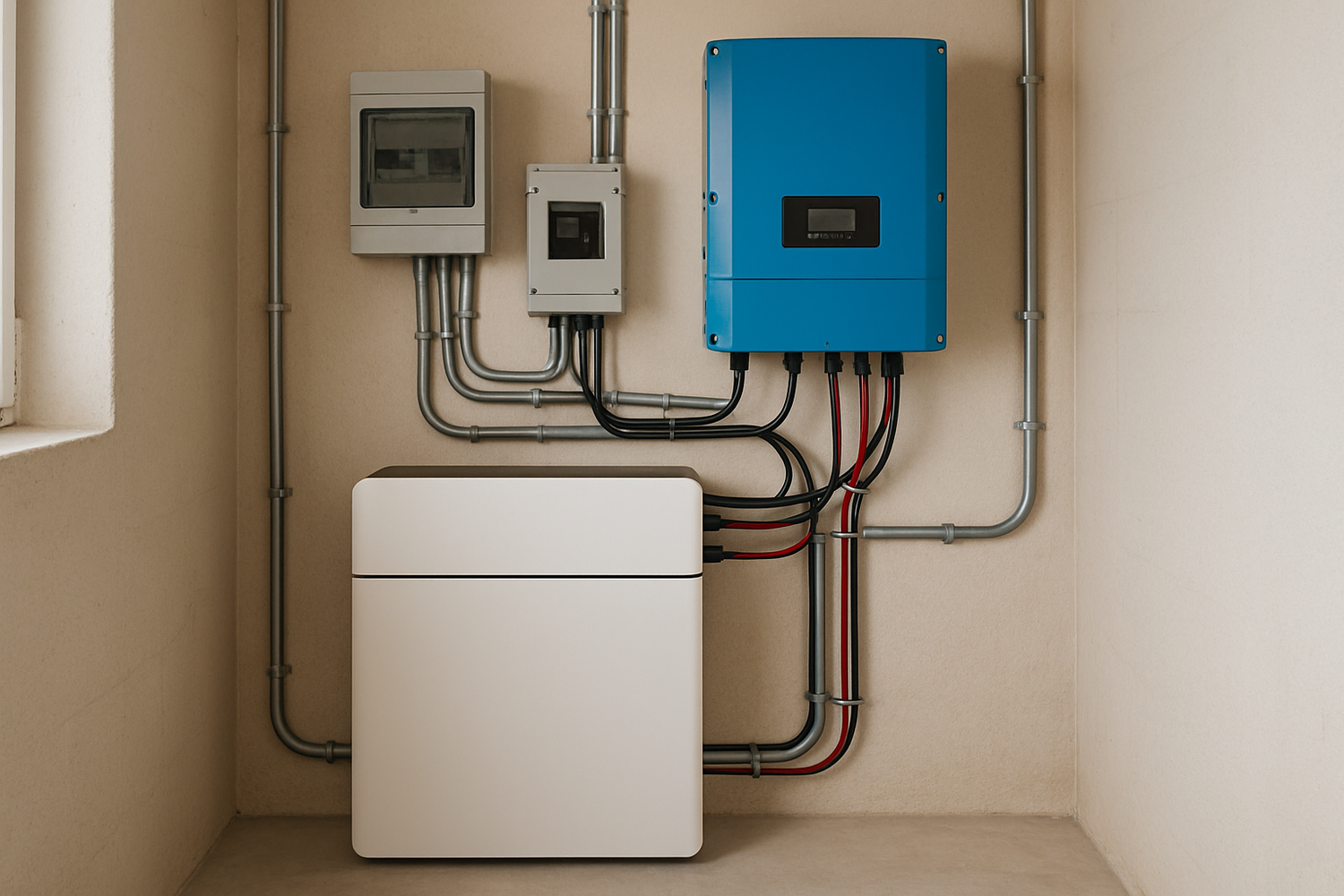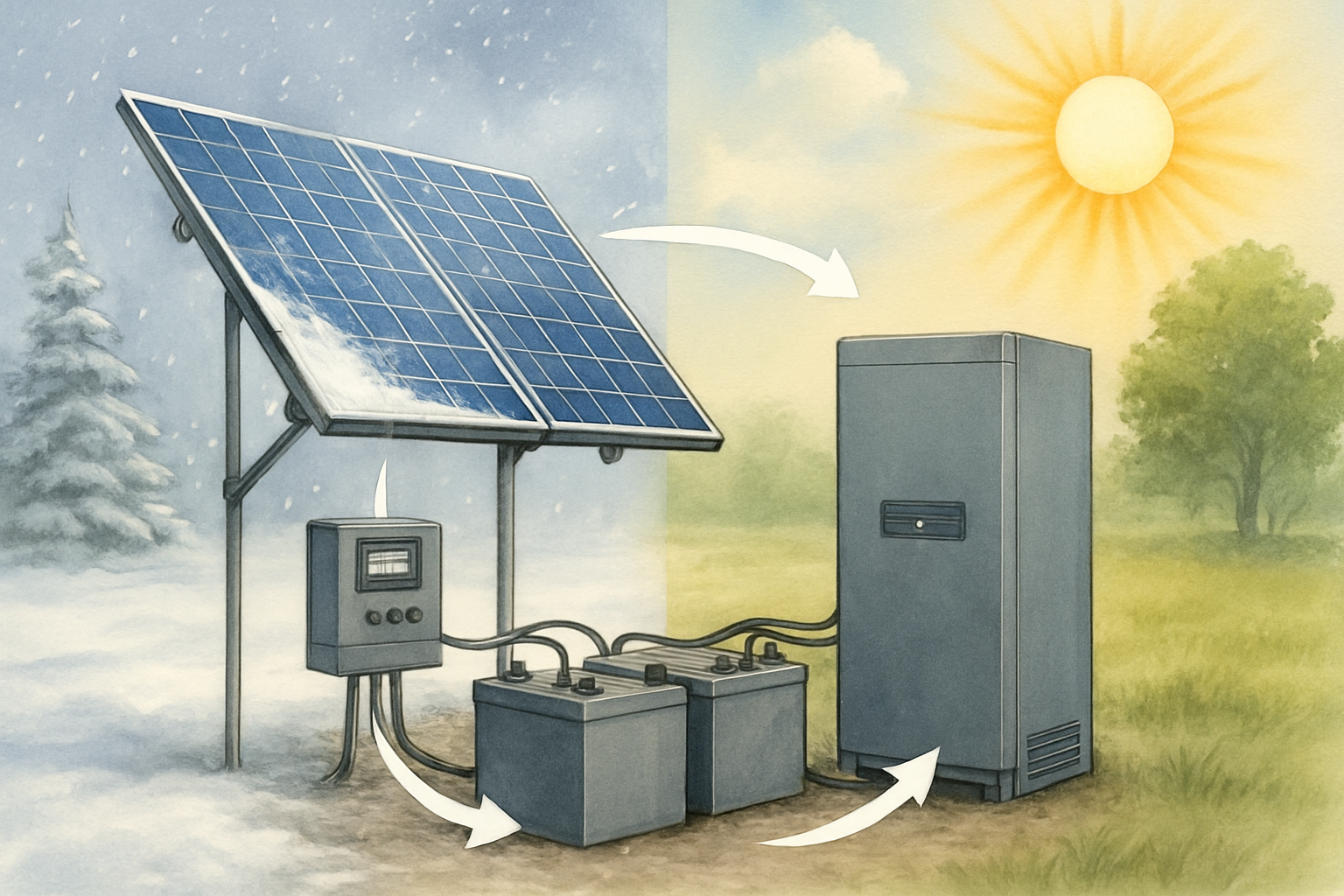In an off-grid power system, your battery bank is the heart of your energy independence. It's the reservoir that stores clean energy from your solar panels, ensuring you have reliable power day and night. But this critical component requires attention. Neglecting proper off-grid battery care can lead to reduced capacity, a shorter lifespan, and unexpected replacement costs. This guide provides a complete framework for off-grid system battery maintenance, helping you protect your investment and secure your energy freedom.
Understanding how to manage your power storage is the first step. With years of experience in developing off-grid solar solutions, we've seen firsthand how proactive maintenance makes all the difference. The right approach not only extends battery life but also enhances the overall performance of your entire system.
Understanding Your Off-Grid Battery: Core Concepts
Effective off-grid power system battery health begins with a solid understanding of a few key principles. Knowing what the numbers on your monitor mean and the type of technology you're using is fundamental to proper care.
Key Metrics for Battery Health
Three terms you will see often are State of Charge (SOC), Depth of Discharge (DoD), and Cycle Life. Think of your battery like a water tank. SOC is how full the tank is, expressed as a percentage. DoD is how much water you take out. Cycle Life is the number of times you can fill and empty the tank before it starts to wear out. Regularly draining the tank completely (a deep DoD) will wear it out much faster than only using half the water before refilling. Managing these metrics is crucial for battery optimization in off-grid setups. For a deeper look at ideal operating ranges, see this Data-Backed Guide: Ideal State of Charge Windows Off-Grid.
LiFePO4 vs. Traditional Lead-Acid Batteries
The type of battery you choose dramatically impacts your maintenance routine. While traditional lead-acid batteries have been used for decades, modern Lithium Iron Phosphate (LiFePO4) technology offers significant advantages in performance, safety, and longevity. LiFePO4 batteries require minimal maintenance, can handle deeper discharge cycles without rapid degradation, and have a much longer cycle life. This makes them an excellent choice for reliable, long-term off-grid living. The differences in care are significant, as detailed in LiFePO4 vs Lead-Acid: Off-Grid Maintenance Differences That Matter.
| Feature | LiFePO4 (Lithium Iron Phosphate) | Flooded Lead-Acid |
|---|---|---|
| Average Lifespan | 10-15+ years (5,000-7,000+ cycles) | 3-7 years (500-1,500 cycles) |
| Maintenance Requirements | Virtually none; no watering required | Regular (checking water levels, equalization charges) |
| Usable Capacity (DoD) | 80-100% recommended | 50% recommended to maximize lifespan |
| Efficiency | ~95% round-trip | ~80-85% round-trip |
| Safety | Very stable chemistry, no off-gassing, low risk of thermal runaway | Risk of hydrogen gas explosion, potential for acid spills |
The Role of the Battery Management System (BMS)
A Battery Management System (BMS) is the brain of a modern battery bank, particularly for lithium chemistries. It acts as a built-in safeguard, protecting the battery cells from damaging conditions like overcharging, over-discharging, and extreme temperatures. An advanced BMS is a core component of any robust battery management off-grid system, ensuring both safety and longevity by keeping every cell operating within its ideal parameters. Properly configuring your BMS is a powerful step in protecting your investment, a topic covered in Smart BMS Settings That Safeguard Off-Grid LiFePO4 Banks.
Proactive Maintenance: Building a Routine for Longevity
Consistency is key to off-grid battery care. A simple, repeatable routine helps you spot potential issues before they become serious problems. While LiFePO4 batteries are famously low-maintenance, a little attention goes a long way in ensuring peak performance for years to come.

Daily and Weekly Observational Checks
Your daily interaction with your system is your first line of defense. Glance at your system monitor to check the battery's State of Charge. Are the readings consistent with the weather and your recent usage? Once a week, take a closer look. Ensure the battery area is clean and free of debris. Check that all connections look secure and that there are no warning lights on your inverter or charge controller. This simple habit is the foundation of a solid care plan, as outlined in How to Build a Weekly Battery Care Routine for Off-Grid Homes.
Monthly and Quarterly Performance Reviews
Once a month, dedicate a few more minutes to a deeper check. Review your system's performance logs if available. Look for trends or anomalies in charging and discharging patterns. Every quarter, it’s a good practice to physically inspect connections. Ensure they are tight, as loose connections can cause performance issues and are a potential fire hazard. These checks help maintain system efficiency and are a core part of 9 Routine Checks to Extend LiFePO4 Battery Lifespan Off-Grid. For a comprehensive strategy, refer to The Off-Grid Battery Maintenance Blueprint for Peak Efficiency.
The Importance of a Clean and Stable Environment
Batteries perform best in a controlled environment. Extreme temperatures, both hot and cold, can negatively affect performance and shorten their lifespan. Ensure your battery bank is in a location that is protected from direct sunlight and has adequate ventilation to prevent heat buildup. In colder climates, insulation may be necessary to keep the batteries within their optimal operating temperature range. A clean, dry, and temperature-stable location is an easy way to promote good off-grid power system battery health.
Optimizing Charging and Discharging Cycles
How you charge and discharge your batteries has a direct impact on their lifespan. Smart usage patterns can add years to your battery bank's life, making battery optimization for off-grid systems a critical skill.
Mastering Charge and Discharge Rates
The speed at which you charge or discharge your battery is known as the C-rate. While LiFePO4 batteries can handle high rates, consistently pushing them to their limits can cause unnecessary stress. A slower, more controlled charge and discharge cycle is generally healthier for the battery. Your system's inverter and solar charge controller are designed to manage this, but understanding the principle helps you manage your energy usage wisely. Learn more by reading the Q&A: What Charge/Discharge Rates Maximize Off-Grid Battery Life?.
Avoiding the Extremes: The Truth About 0% and 100% SOC
One of the most effective ways to extend battery life is to avoid operating at the extreme ends of the charge spectrum. Constantly draining your battery to 0% causes significant strain and can permanently damage the cells. Conversely, while it may seem intuitive, keeping a lithium battery at 100% charge for extended periods can also accelerate degradation. Operating within an ideal SOC window, such as 20% to 80%, can dramatically increase the number of cycles you get from your battery bank. Of course, sometimes you need a full charge, and emergencies happen. For more on these topics, explore Myth vs Reality: Do Off-Grid Batteries Need Full 100% Charges? and the Emergency FAQ: What to Do When Off-Grid Batteries Hit 0% SOC.
Using Monitoring Tools Effectively
An accurate battery monitor is an indispensable tool. It provides a real-time view of your battery's SOC, voltage, and the current flowing in and out. This data empowers you to make informed decisions about your energy consumption. For example, on a cloudy day, you might postpone using a high-power appliance if you see your SOC is lower than usual. These tools are essential for preventing accidental deep discharges, a topic explored in this Tools Review: Battery Monitors and Apps to Prevent Deep Discharge.
Advanced Strategies and Seasonal Adjustments
As you become more familiar with your system, you can implement more advanced strategies to fine-tune its performance and prepare for predictable challenges like changing seasons and severe weather.
Preparing for Different Seasons
Your energy production and consumption patterns will change with the seasons. Winter brings shorter days and less sun, while summer may increase loads from cooling appliances. Adjusting the settings on your solar charge controller and inverter can help optimize performance throughout the year. For instance, you might adjust charge voltage settings to account for colder temperatures. For practical advice, see this Case Study: Winterizing Remote Cabin Batteries to Survive -20C and the Maintenance Roadmap: Seasonal Settings for Inverters and BMS.
Common Mistakes and How to Avoid Them
Many common battery issues are entirely preventable. Some frequent missteps include improperly sizing the battery bank for the load, using incorrect wire sizes, mixing old and new batteries, and ignoring system warnings. Each of these can lead to poor performance and premature failure. Educating yourself on these pitfalls is a crucial part of off-grid system battery maintenance. A great resource for this is Stop Killing Your Off-Grid Batteries: Top 10 Avoidable Mistakes.
Preparing for Adverse Weather
Storms and other adverse weather events can put your system to the test. Before a storm, it's wise to ensure your batteries are as fully charged as possible to maximize your energy reserve. A quick check of all physical connections and ensuring equipment is protected from the elements can prevent weather-related damage. For a detailed guide, use this Checklist Before Storms: Protecting Off-Grid Batteries from Abuse.
Securing Your Energy Independence
Proper battery care is not just about maintenance; it's an investment in your energy security and independence. By understanding the core concepts of your system, establishing a proactive care routine, and using the right technology, you ensure your off-grid home has reliable power for years to come. A high-performance LiFePO4 battery at the center of an integrated energy storage system simplifies this process, providing a dependable and scalable solution for your energy needs.
As technology continues to advance, the tools for managing off-grid power will only get better. Innovations are making these systems smarter and more resilient than ever before. To see what the future holds, you can read about the Trend Watch: AI-Driven Battery Care for Resilient Microgrids. By embracing these best practices today, you are building a foundation for a truly independent and sustainable energy future.
Disclaimer: This article is for informational purposes only. It is not intended to be a substitute for professional electrical, financial, or legal advice. Always consult with a qualified professional before making decisions about your electrical system.





Leave a comment
All comments are moderated before being published.
This site is protected by hCaptcha and the hCaptcha Privacy Policy and Terms of Service apply.